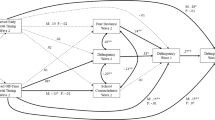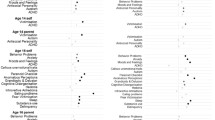Abstract
Earlier research has associated early puberty with emotional and behavioral symptoms particularly among girls, while among boys, findings have been contradictory as to whether risks are associated with early or late pubertal timing. We studied the association between pubertal timing and substance use behaviors in middle adolescence in a 2-year follow up study of 2,070 (mean age 15.5 years, SD 0.36; 56.4% females) Finnish adolescents. Pubertal timing was measured by age at menarche/oigarche. Eleven years or less was classified as early, 12–13 years as normative and 14 years or later as late pubertal timing. Substance use behaviors were elicited by a number of questions related to alcohol use patterns, smoking and cannabis use. As factors that could explain the association between pubertal timing and substance use, we studied depressive symptoms, delinquency and aggression, and parental monitoring. In boys, all these substance use behaviors were the more common the earlier the puberty and the associations persisted at age 17. Among girls, early pubertal timing was similarly associated with substance use behaviors at age 15, but no longer at age 17. The associations between pubertal timing and substance use behaviors persisted when symptom dimensions and parental monitoring were added into the models. Early puberty is a risk factor for substance use particularly among boys. Among girls, the impact of pubertal timing already tempers off during adolescence.
Similar content being viewed by others
References
Achenbach, T. M. (1991). Integrative guide for the 1991 CBL/4–18, YSR, and TRF profiles. Burlington, VT: University of Vermont.
Angold, A., Costello, E., Erkanli, A., & Worthmann, C. (1999). Pubertal changes in hormone levels and depression in girls. Psychological Medicine, 29, 1043–1053.
Anthony, J., & Petronis, K. (1995). Early onset drug use and risk of later drug problems. Drug and Alcohol Dependence, 40, 9–15.
Beck, A. T., Rial, W. Y., & Rickels, K. (1974). Short form of depression inventory: Cross-validation. Psychological Reports, 34, 1184–1186.
Breslau, N., Fenn, N., & Peterson, E. (1993). Early smoking initiation and nicotine dependence in a cohort of young adults. Drug and Alcohol Dependence, 33, 129–137.
Buchanan, C., Eccles, J., & Becker, J. (1992). Are adolescents the victims of raging hormones: Evidence for activational effects of hormones on moods and behavior at adolescence. Psychological Bulletin, 111, 62–107.
Buckstein, O. G., Bernet, W., Arnold, V., Beitchman, J., Shaw, J., Benson, R. S., et al. (2005). Practice parameter for the assessment and treatment of children and adolescents with substance use disorders. Journal of the American Academy of Child and Adolescent Psychiatry, 44, 609–621.
Carlier, J., & Steeno, O. (1985). Oigarche: The age at first ejaculation. Andrologia, 17, 104–106.
Carpenter-Hyland, E., & Chandler, J. (2007). Adaptive plasticity of NDMA receptors and dendritic spines: Implications for enhanced vulnerability of the adolescent brain to alcohol addiction. Pharmacology, Biochemistry and Behavior, 86, 200–208.
Chung, H., Park, Y. S., & Lanza, S. (2005). Latent transition analysis with covariates: Pubertal timing and substance use behaviors in adolescent females. Statistics in Medicine, 24, 2895–2910.
Clark, D. B., Thatcher, D. L., & Tapert, S. F. (2008). Alcohol, psychological dysregulation, and adolescent brain development. Alcoholism, Clinical and Experimental Research, 32, 375–385.
Costello, E., Sung, M., Worthman, C., & Angold, A. (2007). Pubertal maturation and the development of alcohol use and abuse. Drug and Alcohol dependence, 88S, S50–S59.
DeWitt, D., Adlaf, E., Offord, D., & Ogborne, A. (2000). Age at first alcohol use: A risk factor for the development of alcohol disorders. American Journal of Psychiatry, 157, 745–750.
Dick, D., Rose, D., Viken, R., & Kaprio, J. (2000). Pubertal timing and substance use: Associations between and within families across late adolescence. Developmental Psychology, 36, 180–189.
Dorn, L., Nottelmann, E., Susman, E., Inoff-Germain, G., Cutler, G., Jr., & Chrousos, G. (1999). Variability in hormone concentrations and self-reported menstrual histories in young adolescents: Menarche as an integral part of a developmental process. Journal of Youth and Adolescence, 28, 283–304.
Fröjd, S., Kaltiala-Heino, R., & Rimpelä, M. (2007). The association of parental monitoring and family structure with diverse maladjustment outcomes in middle adolescent boys and girls. Nordic Journal of Psychiatry, 61, 296–303.
Ge, X., Conger, R., & Elder, G. (2001). The relationship between pubertal transition and psychological distress among adolescent boys. Journal of Res Adolescence, 11, 49–70.
Ge, X., Conger, R., Simons, R., Brody, G., & McBride Murry, V. (2002). Contextual amplification of pubertal transition effects on deviant peer affiliation and externalizing behavior among African American Children. Developmental Psychology, 38, 42–54.
Ge, X., Kim, I., Conger, R., Brody, G., Simons, R., Gibbons, F., et al. (2003). It’s about timing and change: Pubertal transition effects on symptoms of major depression among African American youths. Developmental Psychology, 39, 430–439.
Ge, X., Brody, G., Conger, R., & Simons, R. (2006). Pubertal maturation and African American children’s internalizing and externalizing symptoms. Journal of Youth and Adolescence, 35, 531–540.
Graber, J., Lewinsohn, P., Seeley, J., & Brooks-Gunn, J. (1997). Is psychopathology associated with the timing of pubertal development? Journal of the American Academy of Child and Adolescent Psychiatry, 36, 1768–1776.
Graber, J., Seeley, J., Brooks-Gunn, J., & Lewinsohn, P. (2004). Is pubertal timing associated with psychopathology in young adulthood? Journal of the American Academy of Child and Adolescent Psychiatry, 43, 718–726.
Graber, J., Brooks-Gunn, J., & Warren, M. (2006). Pubertal effects on adjustment in girls: Moving from demonstrating effects to identifying pathways. Journal of Youth and Adolescence, 35, 413–423.
Hayatbakhsh, M., Najman, J., McGee, T., Bor, W., & O’Callaghan, M. (2009). Early pubertal maturation in the prediction of early adult substance use: a prospective study. Addiction, 104, 59–65.
Hibell, B., Guttormsson, U., Ahlström, S., Balakireva, O., Bjarnason, Y., Kokkevi, A., & Kraus, J. (2007) The 2007 ESPAD report. Substance use among students in 35 European countries. The European school survey project on alcohol and other drugs. www.espad.org.
Kaltiala-Heino, R., Rimpelä, M., Rantanen, P., & Laippala, P. (1999). Finnish modification of the 13-item Beck Depression Inventory in screening an adolescent population for depressiveness and positive mood. Nordic Journal of Psychiatry, 53, 453–457.
Kaltiala-Heino, R., Marttunen, M., Rantanen, P., & Rimpelä, M. (2003). Early puberty is associated with mental health problems in middle adolescence. Social Science and Medicine, 57, 1055–1064.
Kerr, M., & Stattin, H. (2000). What parents know, how they know it, and several forms of adolescent adjustment: Further support for a reinterpretation of monitoring. Developmental Psychology, 36, 366–380.
Kulin, H., Frontera, M., Demers, L., Bartholomew, M., & Lloyd, T. (1989). The onset of sperm production in pubertal boys. Relationship to gonadotropin excretion. American Journal of Diseases of Children, 143, 190–193.
Lintonen, T., Ahlström, S., & Metso, L. (2004). The reliability of self-reported drinking in adolescence. Alcohol and Alcoholism, 39, 362–368.
Lubman, D. I., Hides, L., Yücel, M., & Toumbourou, J. W. (2007). Intervening early to reduce developmentally harmful substance use among youth populations. Medical Journal of Australia, 187(7 Suppl), S22–S25.
Luna, B., Graver, K. E., Urban, T. A., Lazar, N. A., & Sweeney, J. A. (2004). Maturation of cognitive processes from late childhood to adulthood. Child Development, 75, 1357–1372.
Martin, C., Kelly, T., Rayens, M., Brogli, B., Brentzl, A., Smith, J., et al. (2002). Sensation seeking, puberty, and nicotine, alcohol and marijuana use in adolescence. Journal of the American Academy of Child and Adolescent Psychiatry, 41, 1495–1502.
McArdle, P. (2008). Alcohol abuse in adolescents. Archives of Diseases of Children, 93, 527.
McMahon, R. (1999). Child and adolescent psychopathology as risk factors for subsequent tobacco use. Nicotine & Tobacco Research, S2, S45–S50.
Mendle, J., Turkheimer, E., & Emery, R. (2007). Detrimental psychological outcomes associated with early pubertal timing in adolescent girls. Developmental Review, 27, 151–171.
Paus, T., Keshavan, M., & Giedd, J. N. (2008). Why do many mental disorders emerge during adolescence? Nature reviews. Neuroscience, 9, 947–957.
Raitasalo, R. (2007). Mood questionnaire. Finnish modification of the short form of the Beck Depression Inventory measuring depression symptoms and self-esteem. Helsinki: The Social Insurance Institution of Finland.
Rimpelä, A., & Rimpelä, M. (1993). Towards an equal distribution of health? Socioeconomic and regional differences of the secular trend of the age of menarche in Finland from 1979–1989. Acta Paediatrica, 82, 87–90.
Schaefer, F., Marr, J., Aeidel, C., Tilgen, W., & Scharer, K. (1990). Assessment of gonadal maturation by evaluation of spermaturia. Achives of Diseases of Childhood, 65, 1205–1207.
Stattin, H., & Kerr, M. (2000). Parental monitoring: A reinterpretation. Child Development, 71, 1072–1085.
Taga, K., Markey, C., & Friedman, H. (2006). A longitudinal investigation of associations between boys’ pubertal timing and adult behavioral health and well-being. Journal of Youth and Adolescence, 35, 401–411.
Tanner, J. M. (1962). Growth at adolescence. Oxford: Blackwell.
Torikka, A., Kaltiala-Heino, R., Rimpelä, M., & Rantanen, P. (2001). Depression, drinking and substance use among 14- to 16-year-old Finnish adolescents. Nordic Journal of Psychiatry, 55, 351–358.
Van Loon, A., Tijhuis, M., Picavet, S., Surtees, P., & Ormel, J. (2003). Survey non-response in the Netherlands: Effects on prevalence estimates and associations. Annals of Epidemiology, 13(2), 105–110.
Author information
Authors and Affiliations
Corresponding author
Rights and permissions
About this article
Cite this article
Kaltiala-Heino, R., Koivisto, AM., Marttunen, M. et al. Pubertal Timing and Substance Use in Middle Adolescence: A 2-Year Follow-up Study. J Youth Adolescence 40, 1288–1301 (2011). https://doi.org/10.1007/s10964-011-9667-1
Received:
Accepted:
Published:
Issue Date:
DOI: https://doi.org/10.1007/s10964-011-9667-1




